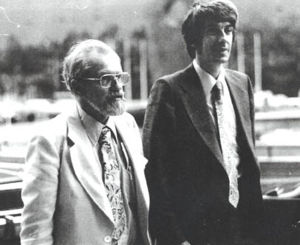Look no further than one J. Allen Hynek, an astronomer and ufologist who had the distinction of both working for Project Bluebook -- the U.S. Air Force investigation into UFO phenomena -- and for publishing a moderately famous book on the subject, The UFO Experience: A Scientific Inquiry. Hynek is the founder of the Center for UFO Studies and, as much as such a thing is possible, is considered a reliable authority on unidentified flying object investigations. In the aformentioned UFO Experience, Hynek laid out three kinds of close encounters to categorize the various UFO reports that he had analyzed (and, most often, debunked) during his tenure as adviser to the Air Force and as a civilian investigator:
- Close encounter of the first kind, wherein a UFO is merely observed
- Close encounter of the second kind, wherein physical evidence of a UFO is recovered
- Close encounter of the third kind, wherein the occupants of a UFO are observed
For his part, Vallée did not explicitly endorse the alien abduction defintion of fourth kind of close encounter, but merely described them as "cases when witnesses experienced a transformation of their sense of reality." Vallée was equally circumspect as to the definition of a close encounter of the fifth kind, the most involved and potentially definitive UFO interaction of the revised close encounter scale.
So, what events comprise a close encounter of the fifth kind?
A close encounter of the fifth kind is described by Jacques Vallée as "cases of lasting physiological impact, such as serious injury or death."
This is considered a somewhat extreme fifth-kind definition by other ufologists -- a group among whom consensus is not necessarily the norm. The competing definition of a close encounter of the fifth kind, one preferred by some SETI researchers, is that of voluntary bilateral communication between UFO occupants and humans. That doesn't necessarily mean a complex world-changing transmission from the stars, as depicted in Carl Sagan's Contact; it could be as simple (if not as heart-warming or Reese's Pieces-peddling) as the one-on-one cute human to cute alien communications depicted in E.T. - The Extra-Terrestrial.
Suffice it to say, a close encounter of the fifth kind goes beyond abduction and confers a definitive, irrefutable consequence of alien contact. One would prefer that consequence be communication rather than injury or death, but that's up to your local ufologist and/or screenwriter to parse out.
As noted, the close encounters of the fourth and fifth kind were not included in Hynek's original three-tiered scale. Thus, the enduring disputes about the precise defintions of these encounter types. A competing extension model of Hynek's scale are the Bloecher sub-types, created by ufologist Ted Bloecher, which simply qualify close encounters of the third kind, rather than extend the scale. Wikipedia lists the seven Bloecher subtypes as follows:
- A: An entity is observed only inside the UFO
- B: An entity is observed inside and outside the UFO
- C: An entity is observed near to a UFO, but not going in or out.
- D: An entity is observed. No UFOs are seen by the observer, but UFO activity has been reported in the area at about the same time
- E: An entity is observed. But no UFOs are seen and no UFO activity has been reported in the area at that time
- F: No entity or UFOs are observed, but the subject experiences some kind of "intelligent communication"
- G: Abduction (same as close encounter of fourth kind)
That's just another of decidedly slapdash distinctions that make define the domain of the Truly Trivial.
SOURCES
TELL ME I'M WRONG
After years of writing trivia columns I've come to embrace the fact that almost everyone reading these things is smarter than me, which is why you always seem to find omissions, mischaracterizations, and outright screw-ups in my work. And like all great businessmen, I intend to profit from my own ignorance and sloth by inviting you, the reader, to call me out on these entertaining little glitches in each Truly Trivial column. The responder with the smartest, best-sourced, and/or most amusing gotcha will earn a place of honor in the subsequent column by having his/her/its comment highlighted next week in this space, along with an excuse, rebuttal or (more likely) half-hearted mea culpa from me. Yes, that is your sense of self-importance rising to the bait. Don't fight it. I dare you.

![Reblog this post [with Zemanta]](http://img.zemanta.com/reblog_b.png?x-id=a5634280-ff5f-48fd-aef6-202dfcea1817)
No comments:
Post a Comment